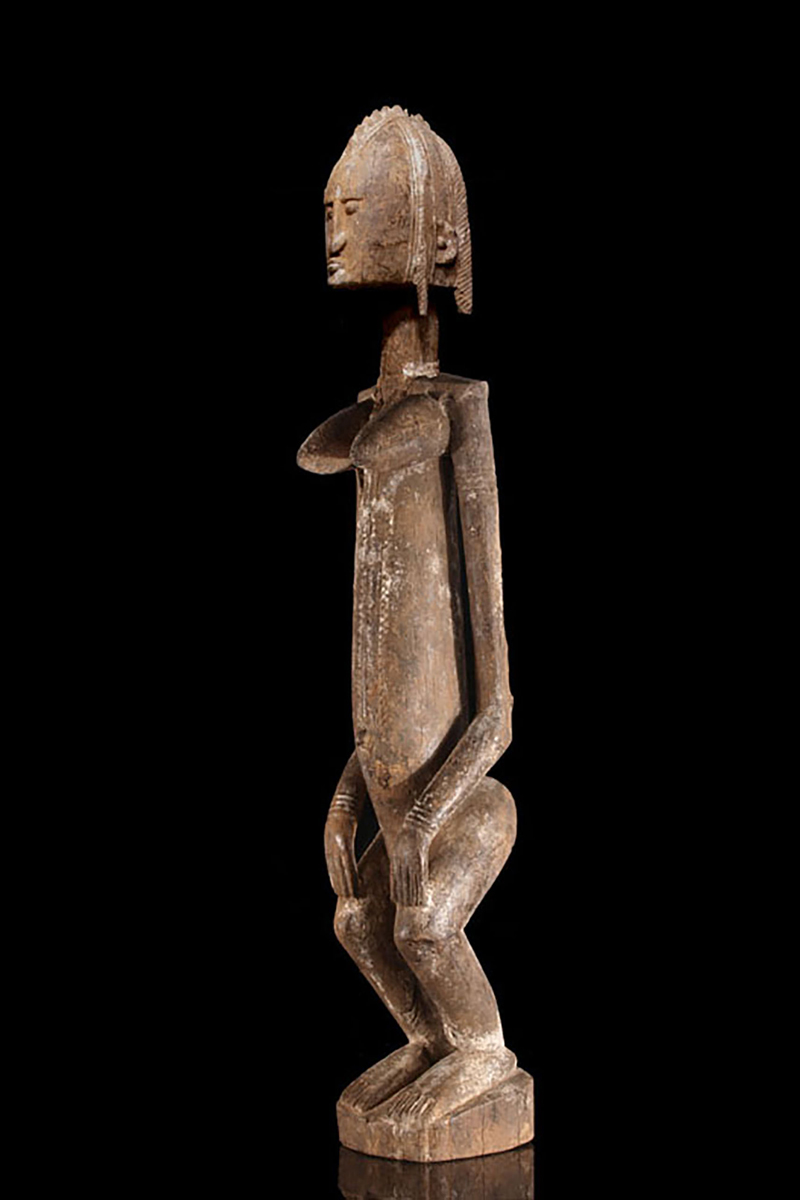|
A large Dogon ancestor sculpture of the Bombu-Toro type, Southern Cliff, probably from the Yugo villages, standing on a rectangular, rounded base, large feet with carved toes, the bent legs ending in prominent buttocks, the slender torso with carved vertical scarifications, the conical breasts protruding, the elongated arms slightly bent, the hands decreasing to the knees, the cylindrical neck surmounted by a helmet shaped head with a comblike middleridge and striaited pigtails close to the ears and at the back, the fine fascial features with small, bulging button-eyes with oxidised iron pupils, the nose arrow-shaped with flaring nostrils; several insect damages, remnants of a kaolin sacrification, heavy, hard wood with significant signs of age and erosion, it is the first time we saw a Dogon sculpture of the Bombu-Toro type with a kaolin sacrification-patina. "Dogon art presents a broad range of object types and styles. Among the human figures alone, some are well over life-size, while others are barely a few inches in height. Their repertoire of gestures is also varied, and includes figures standing, kneeling, sitting, or riding, raising one or both arms in a variety of poses, and holding or wearing articles related to their gender, age, occupation, or social status. In style they vary from full-volumed, sensitively modeled sculptures that are highly descriptive in their details to works that are reduced to abstract geometric shapes stripped of all but the barest references to human anatomy. The surfaces of Dogon sculptures also suggest that they are treated in a variety of ways and may therefore have a range of meanings. While some works are smooth, oiled, and polished, others are thickly coated with sacrificial materials, sometimes to the point of obscuring their sculptural form. The range of styles and imagery seen in Dogon sculpture suggests that they embody richer and more varied references than the simple identification as images of Nommo would encompass. Even if the ultimate meaning of Dogon art depends upon the concept of Nommo, as Griaule and Dieterlen and their followers propose, this meaning an only be enriched by adding to it the many other levels of meaning that arise from the particular settings in which the objects are located. The Dogon place wood figures depicting men and women on many different kinds of altars, most of which are dedicated to ancestors, either real or mythical. Although figurative sculptures, called dege, are perhaps the most interesting types of Dogon art, varied in form and rich in imagery, they are also among the least well documented. Few altars have been described in detail or illustrated; those that have been described do not suggest any consistent pattern linking a particular style of figure or a specific posture or gesture with any one kind of altar. There is also little information with which to identify the persons represented by the figures. The characteristics of this (Bomu-Toro) style are: no fascial scarifications; simple lines, even stark volumes; no realistic traits, everything being geometrically defined; arrow-shapes nose with flaring nostrils; button- or lozenge-shaped eyes; no prognathism but a beard and lip plug; hairstyle in form of a crest for ancestor statues; ornaments such as jewelery, especially sculpted bracelets and earings added on (note that the anklets were exclusvely reserved for the Hogon), contrary to the statues of many other ethnic groups, the mouths are always closed." Hélèn Leloup, Dogon Statuary, 1995; plate 74 - 97, page 159 Auctionhouse results: :Sothebys, Sothebys, Casa d´Asta Captolium Art, Christies, Lemperts, Artkhade Museum: Gallery: Barakat Gallery Height: 104 cm |
 photo: wolfgang-jaenicke.com, for more information, please write us an e-mail with the identification number of the photo identification no. PC076619.jpg |